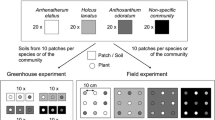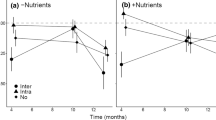Abstract
Background
Current knowledge of plant-soil feedback is based largely on single end point studies with soils conditioned by monocultures, but accounting for variability in the ecological impacts of feedback effects may require understanding how feedback develops over time and in multi-species plant communities.
Methods
To examine temporal development and additivity of feedback, two pairs of native and non-native congeneric grasses were grown alone or in mixtures to create six soil conditioning treatments. We measured plant growth and feedback on the soils over 19 months and addressed whether plant biomass was additive or non-additive between soils treated by mixtures and their constituent monocultures.
Results
For native grasses, plant-soil feedback either became progressively more negative through time or switched from neutral to negative. Feedback to non-native grasses was variably neutral to positive. Final biomass of the grasses growing on soils conditioned by mixtures was generally an additive function of growth on soils conditioned by the component monocultures, except native grasses growing in soils conditioned by their own congener mixtures, which were non-additive.
Conclusions
Temporal variation and non-additivity in feedback suggest that extrapolation to communities may be complex. More work is needed to assess the generality of temporal and scaling effects.



Similar content being viewed by others
References
Bardgett RD, Bowman WD, Kaufmann R, Schmidt SK (2005) A temporal approach to linking aboveground and belowground ecology. Trends Ecol Evol 20:634–641
Bartelt-Ryser J, Joshi J, Schmid B, Brandl H, Balser T (2005) Soil feedbacks of plant diversity on soil microbial communities and subsequent plant growth. Perspect Plant Ecol Evol Syst 7:27–49
Batten K, Scow K, Espeland E (2008) Soil microbial community associated with an invasive grass differentially impacts native plant performance. Microb Ecol 55:220–228
Bever JD (1994) Feeback between plants and their soil communities in an old field community. Ecology 75:1965–1977
Bever JD (2003) Soil community feedback and the coexistence of competitors: conceptual frameworks and empirical tests. New Phytol 157:465–473
Bever JD, Westover KM, Antonovics J (1997) Incorporating the soil community into plant population dynamics: the utility of the feedback approach. J Ecol 85:561–573
Bezemer TM, Lawson CS, Hedlund K, Edwards AR, Brook AJ, Igual JM, Mortimer SR, van der Putten WH (2006) Plant species and functional group effects on abiotic and microbial soil properties and plant-soil feedback responses in two grasslands. J Ecol 94:893–904
Bonanomi G, Mazzoleni S (2005) Soil history affects plant growth and competitive ability in herbaceous species. Community Ecol 6:23–28
Bonanomi G, Giannino F, Mazzoleni S (2005) Negative plant-soil feedback and species coexistence. Oikos 111:311–321
Brandt AJ, Seabloom EW, Hosseini PR (2009) Phylogeny and provenance affect plant-soil feedbacks in invaded California grasslands. Ecology 90:1063–1072
Callaway RM, Thelen GC, Rodriguez A, Holben WE (2004) Soil biota and exotic plant invasion. Nature 427:731–733
Casper BB, Castelli JP (2007) Evaluating plant-soil feedback together with competition in a serpentine grassland. Ecol Lett 10:394–400
Casper BB, Jackson RB (1997) Plant competition underground. Annu Rev Ecol Syst 28:545–570
Casper BB, Bentivenga SP, Ji BM, Doherty JH, Edenborn HM, Gustafson DJ (2008) Plant-soil feedback: testing the generality with the same grasses in serpentine and prairie soils. Ecology 89:2154–2164
Cox JR, Martin-R MH, Ibarra-F FA, Fourie JH, Rethman JFG, Wilcox DG (1988) The influence of climate and soils on the distribution of four African grasses. J Range Manage 41:127–139
Diez JM, Dickie I, Edwards G, Hulme PE, Sullivan JJ, Duncan RP (2010) Negative soil feedbacks accumulate over time for non-native plant species. Ecol Lett 13:803–809
Eisenhauer N, Beßler H, Engels C, Gleixner G, Habekost M, Milcu A, Partsch S, Sabais ACW, Scherber C, Steinbeiss S, Weigelt A, Weisser WW, Scheu S (2010) Plant diversity effects on soil microorganisms support the singular hypothesis. Ecology 91:485–496
Elgersma K, Yu S, Vor T, Ehrenfeld J (2012) Microbial-mediated feedbacks of leaf litter on invasive plant growth and interspecific competition. Plant Soil 356:341–355
Eppstein MJ, Molofsky J (2007) Invasiveness in plant communities with feedbacks. Ecol Lett 10:253–263
Eppstein MJ, Bever JD, Molofsky J (2006) Spatio-temporal community dynamics induced by frequency dependent interactions. Ecol Model 197:133–147
Gabbard B, Fowler N (2007) Wide ecological amplitude of a diversity-reducing invasive grass. Biol Invasions 9:149–160
Grman E, Suding KN (2010) Within-year soil legacies contribute to strong priority effects of exotics on native California grassland communities. Restor Ecol 18:664–670
Harrison KA, Bardgett RD (2010) Influence of plant species and soil conditions on plant–soil feedback in mixed grassland communities. J Ecol 98:384–395
Hausmann NT, Hawkes CV (2009) Plant neighborhood control of arbuscular mycorrhizal community composition. New Phytol 183:1188–1200
Hawkes CV, Wren IF, Herman DJ, Firestone MK (2005) Plant invasion alters nitrogen cycling by modifying the soil nitrifying community. Ecol Lett 8:976–985
Hooper DU, Dukes JS (2004) Overyielding among plant functional groups in a long-term experiment. Ecol Lett 7:95–105
Husband R, Herre EA, Turner SL, Gallery R, Young JPW (2002a) Molecular diversity of arbuscular mycorrhizal fungi and patterns of host association over time and space in a tropical forest. Mol Ecol 11:2669–2678
Husband R, Herre EA, Young JPW (2002b) Temporal variation in the arbuscular mycorrhizal communities colonising seedlings in a tropical forest. FEMS Microbiol Ecol 42:131–136
Kardol P, Bezemer TM, van der Putten WH (2006) Temporal variation in plant-soil feedback controls succession. Ecol Lett 9:1080–1088
Kardol P, Cornips NJ, van Kempen MML, Bakx-Schotman JMT, van der Putten WH (2007) Microbe-mediated plant-soil feedback causes historical contingency effects in plant community assembly. Ecol Monogr 77:147–162
Klironomos JN (2002) Feedback with soil biota contributes to plant rarity and invasiveness in communities. Nature 417:67–70
Kulmatiski A, Beard KH (2011) Long-term plant growth legacies overwhelm short-term plant growth effects on soil microbial community structure. Soil Biol Biochem 43:823–830
Kulmatiski A, Kardol P (2008) Getting plant-soil feedbacks out of the greenhouse: experimental and conceptual approaches. In: Luttge U, Beyschlag W, Murata J (eds) Progress in botany. Springer, Berlin, pp 449–472
Kulmatiski A, Beard KH, Stevens JR, Cobbold SM (2008) Plant-soil feedbacks: a meta-analytical review. Ecol Lett 11:980–992
Kulmatiski A, Heavilin J, Beard KH (2011) Testing predictions of a three-species plant-soil feedback model. J Ecol 99:542–550
Levine JM, Pachepsky E, Kendall BE, Yelenik SG, Lambers JHR (2006) Plant-soil feedbacks and invasive spread. Ecol Lett 9:1005–1014
Loreau M (1998) Separating sampling and other effects in biodiversity experiments. Oikos 82:600–602
Mangan SA, Schnitzer SA, Herre EA, Mack KML, Valencia MC, Sanchez EI, Bever JD (2010) Negative plant-soil feedback predicts tree-species relative abundance in a tropical forest. Nature 466:752–755
Manning P, Morrison S, Bonkowski M, Bardgett R (2008) Nitrogen enrichment modifies plant community structure via changes to plant-soil feedback. Oecologia 157:661–673
McLaughlin SB, Adams Kszos L (2005) Development of switchgrass (Panicum virgatum) as a bioenergy feedstock in the United States. Biomass Bioenergy 28:515–535
Mills KE, Bever JD (1998) Maintenance of diversity within plant communities: soil pathogens as agents of negative feedback. Ecology 79:1595–1601
Molofsky J, Bever JD, Antonovics J (2001) Coexistence under positive frequency dependence. Proc R Soc London, Ser B 268:273–277
Moora M, Berger S, Davison J, Öpik M, Bommarco R, Bruelheide H, Kühn I, Kunin WE, Metsis M, Rortais A, Vanatoa A, Vanatoa E, Stout JC, Truusa M, Westphal C, Zobel M, Walther G-R (2011) Alien plants associate with widespread generalist arbuscular mycorrhizal fungal taxa: evidence from a continental-scale study using massively parallel 454 sequencing. J Biogeogr 38:1305–1317
Pernilla Brinkman E, van der Putten WH, Bakker E-J, Verhoeven KJF (2010) Plant-soil feedback: experimental approaches, statistical analyses and ecological interpretations. J Ecol 98:1063–1073
Petermann JS, Fergus AJF, Turnbull LA, Schmid B (2008) Janzen-Connell effects are widespread and strong enough to maintain diversity in grasslands. Ecology 89:2399–2406
Reinhart KO, Packer A, van der Putten WH, Clay K (2003) Plant-soil biota interactions and spatial distribution of black cherry in its native and invasive ranges. Ecol Lett 6:1046–1050
Reynolds HL, Packer A, Bever JD, Clay K (2003) Grassroots ecology: plant-microbe-soil interactions as drivers of plant community structure and dynamics. Ecology 84:2281–2291
van de Voorde TFJ, van der Putten WH, Martijn Bezemer T (2011) Intra- and interspecific plant–soil interactions, soil legacies and priority effects during old-field succession. J Ecol 99:945–953
van der Heijden MGA, Horton TR (2009) Socialism in soil? The importance of mycorrhizal fungal networks for facilitation in natural ecosystems. J Ecol 97:1139–1150
van der Putten WH, Peters BAM (1997) How soil-borne pathogens may affect plant competition. Ecology 78:1785–1795
van der Putten WH, van Dijk C, Peters BAM (1993) Plant-specific soil-borne diseases contribute to succession in foredune vegetation. Nature 362:53–56
van der Putten WH, Kowalchuk GA, Brinkman EP, Doodeman GTA, van der Kaaij RM, Kamp AFD, Menting FBJ, Veenendaal EM (2007) Soil feedback of exotic savanna grass relates to pathogen absence and mycorrhizal selectivity. Ecology 88:978–988
van der Stoel CD, van der Putten WH, Duyts H (2002) Development of a negative plant–soil feedback in the expansion zone of the clonal grass Ammophila arenaria following root formation and nematode colonization. J Ecol 90:978–988
van Grunsven RHA, van der Putten WH, Bezemer TM, Tamis WLM, Berendse F, Veenendaal EM (2007) Reduced plant-soil feedback of plant species expanding their range as compared to natives. J Ecol 95:1050–1057
Wagg C, Jansa J, Schmid B, van der Heijden MGA (2011) Belowground biodiversity effects of plant symbionts support aboveground productivity. Ecol Lett 14:1001–1009
Yelenik SG, Levine JM (2011) The role of plant-soil feedbacks in driving native-species recovery. Ecology 92:66–74
Acknowledgments
The authors thank E. Brault, D. Carbajal, N. Johnson, J. Rocca, and other members of the Hawkes lab for assistance with lab and fieldwork. An earlier draft of this manuscript was significantly improved by comments from B. Casper. Support for this research was provided to CVH by the National Research Initiative of the USDA Cooperative State Research, Education, and Extension Service (Grant # 2005–02860).
Author information
Authors and Affiliations
Corresponding author
Additional information
Responsible Editor: Juha Mikola.
Rights and permissions
About this article
Cite this article
Hawkes, C.V., Kivlin, S.N., Du, J. et al. The temporal development and additivity of plant-soil feedback in perennial grasses. Plant Soil 369, 141–150 (2013). https://doi.org/10.1007/s11104-012-1557-0
Received:
Accepted:
Published:
Issue Date:
DOI: https://doi.org/10.1007/s11104-012-1557-0




